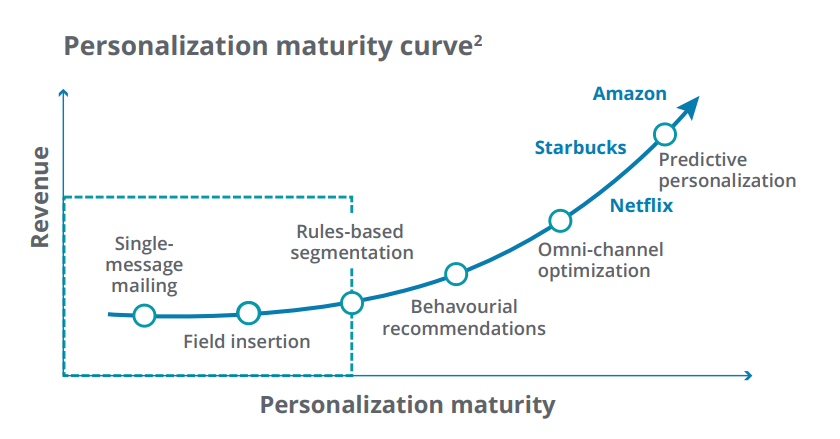Personalization is so yesterday. Imagine walking into your favorite bakery, and the owner instantly whips up your usual before you even order. Or, opening Netflix to find that perfect show waiting for you – no endless scrolling required. That is hyper-personalization, the marketing magic that treats every customer like a cherished regular. In today's digital age, where tech connects us like never before, consumers crave these tailored experiences. And businesses that master them thrive. So, is there a need to explain why hyper personalization is essential for your business’ success?
What is hyper-personalization?
Hyper-personalization is a marketing approach tailored to each customer through the smart mixture of data and cutting-edge technology. It advances beyond simple personalization techniques such as inserting a name into an email and rules-based segmentation. Instead, it crafts distinct experiences for each user and develops predictive personalization techniques.
This method utilizes customer data, analytics, and the combined power of artificial intelligence and automation to present messages and offers that are specifically customized. Examples of this could be ads that align closely with a user's interests, recommendations for products or content that seem handpicked, pricing that adjusts to individual preferences, and landing pages that feel uniquely designed for each visitor.

The key enablers of hyper-personalization are:
- Data collection and analysis – gathering extensive first- and third-party customer data,
- Advanced analytics and AI – identifying insights and patterns from data to inform personalization,
- Technology – using tools like recommendation engines, chatbots and multi-channel APIs to execute hyper-personalized campaigns.
A hyper-personalized experience feels like it has been created just for you. It shows customers their unique needs are not only understood, but actively anticipated and catered to. The end goal is simple; create a consistently outstanding, individualized experience at every touchpoint throughout each customer’s unique journey.
For example, when you book a trip on Expedia, you may later see hotel recommendations for destinations matching your previous travel preferences and budget. Or if you browse running shoes on an ecommerce site, you could get an email reminding you about items still in your cart.
This kind of context-sensitive interaction builds emotional bonds between brands and their audiences. It turns generic, one-size-fits-all marketing into messages and offers that appear specifically crafted for each individual.
Why does hyper-personalization matter?
There are several key reasons why brands must prioritize hyper-personalization now:
- It is what customers expect. After experiencing tailored recommendations from the likes of Netflix and Amazon, people anticipate that level of personalization across all brand interactions. Research shows 90% find personalized ads appealing and 80% are more likely to buy from personalized brands.
- It drives revenue. Hyper-personalization boosts metrics like clickthrough rates, conversion rates, average order values and customer lifetime value. For example, recommending products based on purchase history alone generates 35% of Amazon’s conversions.
- It inspires loyalty. By using data to demonstrate an intimate understanding of each customer, hyper-personalization marketing fosters trust and emotional connections. This makes existing customers more likely to buy again, spend more and recommend your brand.
- It maximizes marketing impact. Branded content constantly competes for shrinking consumer attention spans. Hyper-personalization marketing ensures your messages resonate by only reaching highly targeted audiences with relevant offers.
- It keeps you competitive. Forward-thinking brands like Starbucks, Nike and Tastry are the best hyper-personalization examples setting new standards for 1:1 customer experiences. To attract top talent and prevent losing market share, hyper-personalization must be part of your strategy.
In essence, hyper-personalization represents the next frontier for brands to lock in differential advantage. It enables you to stand out through superior understanding of – and engagement with – your customers.
Benefits of hyper-personalization
Now we shall explore some of the concrete ways properly implemented hyper-personalization pays off:
- Increased revenue – hyper-personalized content and offers convert at higher rates. When you accurately align messaging to customer needs, you waste less budget and drive more sales,
- Lower costs – automating parts of customer communication via bots and triggering personalized emails based on set rules saves human hours. And when existing customers purchase more, it cuts down expensive acquisition efforts,
- Improved retention – by providing tailored recommendations and offers based on an individual’s taste and preferences, brands reinforce emotional connections that inspire loyalty and repeat purchases. Streaming service Spotify’s extremely personalized playlists Discover Weekly keep subscribers engaged twice as long as users who do not use it.
- Deeper insights – collecting and analyzing customer data to power personalization gives brands useful learnings about audience values, pain points and ever-evolving needs. Cosmetics retailer Sephora uncovered insights around skincare routines from online product reviews.
Firms that are proficient in personalization achieve a 40 percent higher revenue from such endeavors compared to their average counterparts. With ROI potential like this, hyper-personalization should be central to your growth strategy.
Challenges of hyper-personalization
Of course, doing hyper-personalization well presents difficulties too:
- Getting adequate data – truly personalized experiences rely on robust information about each customer. If databases lack enough first-party data, brands must invest in collecting more across touchpoints,
- Analyzing data effectively – sophisticated analytics and automation tools are essential for extracting insights from consumer data. Many brands struggle getting needed capabilities and in-house expertise,
- Overcoming creepiness factor – customers can perceive hyper-personalization as intrusive or creepy if done poorly. Brands must carefully navigate data usage and transparently gain user consent,
- Respecting privacy – collecting consumer data risks provoking privacy concerns, especially in an era of increased data regulations. Brands must ensure compliance and secure storage for user info,
- Continuously optimizing – even advanced hyper-personalization initiatives require constant testing and iteration guided by performance metrics. Optimization never stops.
While challenges exist, the customer experience (CX) upside makes overcoming them an imperative. Now let’s see hyper-personalization in action.
Hyper-personalization examples
From retail to banking, innovative strategies that combine data-driven insights with personalized approaches are redefining consumer engagement. Here are some compelling examples of hyper-personalization and how it is reshaping the customer journey in different sectors.
Omnichanel hyper-personalization in retail
Omnichannel hyper-personalization in retail represents a transformative approach, integrating advanced algorithms and human expertise to reshape the consumer experience.
This concept is exemplified by companies like Stitch Fix and Nike, who have pioneered in applying sophisticated data analytics to personalize customer interactions across multiple channels.
Stitch Fix's approach to understanding latent style is a testament to the power of combining algorithmic precision with human intuition. Their method involves a 'humans-in-the-loop' framework, which integrates algorithmic recommendations with human oversight. For instance, they use matrix factorization, a technique that predicts customer preferences for items based on biases and embedded vectors of users and items. This method not only refines product recommendations but also aids in inventory planning, marketing strategies, and overall business decision-making.
In their pursuit of deciphering style, Stitch Fix employs techniques like principal component analysis (PCA) on latent embeddings to gain insights into customer preferences. This data-driven approach enables them to categorize items and styles effectively, helping stylists make informed recommendations.
For example, by analyzing the polarizing styles, e.g. boho and preppy, they can tailor their inventory to cater to distinct customer preferences.
Another great success of hyper-personalization in retail is the “Nike By You” program. It offers customers the ability to customize their own Nike shoes. This initiative allows for a deeply personal shopping experience, where customers can choose from various styles, colors, and materials on the Nike By You website. The process is enhanced by interactive 3D design tools and expert advice from Nike designers, encouraging customers to infuse their personal identity into their shoe designs. Customers can even add a unique Personal I.D., like a nickname or mantra, making each pair a distinct representation of individual style. This strategy enhances customer involvement and turns buying into a more intimate and unforgettable journey, showcasing the strength of personalized retail in fostering brand loyalty.
Hyper-personalization in banking
In the traditionally conservative finance world, some banks are disrupting customer service expectations via AI-driven hyper-personalization. Monzo Bank, Finch, and Debbie at the forefront of this transformation.

Monzo Bank, a UK-based digital bank, exemplifies hyper-personalization in banking by utilizing sophisticated algorithms to analyze customer transactions. This analysis provides valuable insights into spending patterns, empowering customers with personalized budgeting tools and financial advice. The Monzo app automatically categorizes expenditures, enabling customers to easily set and track spending targets and savings objectives, thus offering a banking experience that is tailored to individual financial behaviors.
Finch stands out by merging traditional banking features with investment opportunities. It adapts investment strategies to align with each customer's unique spending habits and financial aspirations, making personal finance management more dynamic. A notable feature of Finch is the ability to earn returns on checking account balances, reflecting a deep understanding of its customers' financial needs and goals.
On the other hand, Debbie, a U.S.-based fintech app, focuses on hyper-personalized solutions and rewards customers for paying off their debt. Leveraging AI, Debbie analyzes individual financial situations and offers bespoke debt repayment strategies. It also helps to negotiate with creditors on behalf of users.
Where to start your hyper-personalization journey?
Let’s step into your customer's world. To understand their expectations and identify opportunities for enhanced hyper-personalization, it is necessary to scrutinize every touchpoint in the customer journey.
Study your customer journey
Do you know how customers interact with your brand at every stage of their buying process? Start with recording all interactions, no matter if they are positive or negative. Pay close attention to any issues and discrepancies between what customers expect and what they actually experience.
You might also want to conduct interviews or focus groups to get deeper into customer perspectives. A thorough understanding of the customer journey paves the way for more targeted and efficient personalization tactics, ultimately leading to improved customer satisfaction and loyalty.
Identify your customer needs
Transitioning from understanding the journey to identifying specific needs, the next step leading to hyper-personalization involves a going even deeper into customer data:
- Segment users using analytics tools to understand their core values, preferences, and priorities,
- Build detailed customer profiles with diverse data including demographics, behavior, and transaction history,
- Source data from direct interactions, purchase histories, web traffic, social media, and surveys.
- Continuously update these profiles with new data for ongoing relevance and precision.
Understanding your customers' needs is critical for a hyper-personalization strategy that hits the mark. Leverage AI for sophisticated analytics to break down your user base and delve into what really drives them. Creating rich customer profiles requires a mix of data, ranging from basic demographic details to complex behavioral and transactional insights. This information should come from both your own interactions with customers and external sources like web and social media analytics.
Merging this data provides a layered understanding of your customers, allowing for marketing and service approaches that are finely tuned to their needs. Keep these profiles dynamic, updating them with fresh data to maintain their relevance and accuracy.
Understand the current state of your data
A comprehensive data audit is imperative to understand your current capabilities and limitations in customer data utilization:
- Evaluate the types and quality of customer data you collect, the formats in which this data is stored, and your current analysis capabilities.
- Determine any gaps or shortcomings that prevent you from delivering truly personalized messaging and experiences.
- Following this evaluation, map out the optimal future state of your data infrastructure and identify the necessary technology investments to achieve this vision.
This may include upgrading data storage solutions, implementing advanced analytics software, or integrating new data sources. The goal is to build a robust, scalable data framework that supports sophisticated personalization tactics.
Create a roadmap that defines what, when, and how is being implemented
The goal of creating your hyper-personalization roadmap is simple; pinpoint priority touchpoints for personalization across the customer journey. However, mapping out this plan, you will need to consider both the complexity of integration and the potential for campaign performance lift at each stage.
This roadmap should strategically sequence the rollout of personalization initiatives, balancing the pursuit of quick wins that demonstrate immediate value with more substantial, long-term advancements. It is also important to factor in resource allocation, timelines, and potential risks or challenges that may arise during implementation.
Stick to it
It is essential to maintain a flexible, iterative approach even after the initial launch of hyper-personalization campaigns. This means continuously refining and adjusting your strategies based on real-world performance data. Regularly revisit and update data inputs, analytics logic, and message triggers to ensure they remain effective and relevant. To facilitate this ongoing optimization, consider appointing a dedicated optimization owner or team.
This individual or group should be responsible for monitoring campaign performance, identifying areas for improvement, and implementing changes. They should also champion a culture of experimentation and learning within the organization, encouraging teams to test new ideas and approaches. This sustained commitment to optimization is key to realizing the full potential of hyper-personalization and achieving long-term success.
Need help? We can help
Bring the future forward at your company. Hyper-personalization represents a new paradigm for customer engagement – and competitive separation. Write to us today through this contact form to begin crafting your roadmap now.





.png)

